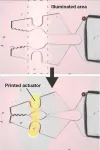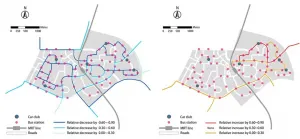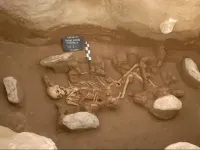(Press-News.org) A study published in Cretaceous Research expands the paleontological richness of continental fossils of the Lower Cretaceous with the discovery of a new water plant (charophytes), the species Mesochara dobrogeica. The study also identifies a new variety of carophytes from the Clavator genus (in particular, Clavator ampullaceus var. latibracteatus) and reveals a set of paleobiographical data from the Cretaceous much richer than other continental records such as dinosaurs'.
Among the authors of the study are Josep Sanjuan, Alba Vicente, Jordi Pérez-Cano and Carles Martín-Closas, members of the Faculty of Earth Sciences and the Biodiversity Research Institute (IRBio) of the University of Barcelona, in collaboration with the expert Marius Stoica, from the University of Bucharest (Romania).
Charophytes: a tool for biostratigraphy
Charophytes are pluricellular algae considered to be the ancestors of vascular plants. Since the Silurian period to date, they have occupied several lacustrine water environments (oligotrophic, alkaline and brackish waters). Nowadays, the anthropic action (exploitation of natural habitat, drainage of wet areas, pollution, etc.) is a threat to the conservation of charophyte pruderies.
For the scientific community, the fossil remains of charophytes -specially, their calcified fructifications- are abundant microfossils with a high biostratigraphy value in the dating of stratum at a local and regional scale. With a wide distribution and high rate of evolution and extinction, some species became excellent fossil indicators of the relative age of continental units.
Water flora in the lakes of the ancient Tethys Ocean islands
The study published in the journal Cretaceous Research focused on the analysis of the water paleoenvironments rich in charophytes in two continental formations -Z?voaia and Gherghina-, dominated by clay, silt and loam of lacustrine origins.
In the Lower Cretaceous, the charophytes flora of the paleo-islands of the large archipelago that built the area of current Europe and Maghreb revealed a defined biogeographical identity. In the islands of the archipelago of the ancient Tethys Ocean, the Clavatoraceae family stood out for its abundance and biodiversity.
The conclusions show a coincidence of 75% of taxons of the charophytes of the Iberia and Hateg (Romania) paleo-islands "that would differentiate these insular flowers from neighbouring continental flora, both Asiatic ones in the east and North-American ones in the western area", notes Josep Sanjuan, lecturer at the Department of Earth and Ocean Dynamics and first author of the article.
Despite the high affinity that existed between the charophyte flora of the islands that built the archipelago of the ancient Tethys Ocean, "there could also be island endemisms," says researcher Alba Vicente, who works at the National Autonomous University of Mexico. The dominant taxa on these islands from the past belong to the Clavatoraceae, an extinct family of charophytes. "Specifically, two subfamilies are represented (Clavatoroidae and Atopocharoidae), and one of the most prominent and common genera in all these islands was Globator, its evolution is a very useful tool for dating the continental successions of the Lower Cretaceous", note the experts Jordi Pérez-Cano and Carles Martín-Closas.
New findings in the charophyte paleontological records
The new species Mesochara dobrogeica is a gyrogonite -the fossilized oospore of charophytes- in the ovoid morphology with pointed apex and base. This small sized fossil fructification -which is about 385 microns high and 310 microns wide- presents apical pore shaped ornamentation. "This new species from the Mesochara genus would be the oldest ornamented piece of the current charophyte Charoidae family", notes Josep Sanjuan, who also collaborates with the American University of Beirut (Lebanon).
The Clavator ampullaceus var. latibracteatus is a new variety of charophyte fossil that shows a type of fruiting, the utricle, large in size (about 769 microns high and 802 microns wide) with bilateral symmetry. It consists of a phylloid - a leaf-like structure close to the main axis, two internal lateral bract cells and a bract cell in abaxial position. The two internal bract cells appear near the apical pore and have a complex structure that characterizes this new variety.
INFORMATION:
Ishikawa, Japan - Inside our cells, and those of the most well-known lifeforms, exist a variety of complex compounds known as "molecular motors." These biological machines are essential for various types of movement in living systems, from the microscopic rearrangement or transport of proteins within a single cell to the macroscopic contraction of muscle tissues. At the crossroads between robotics and nanotechnology, a goal that is highly sought after is finding ways to leverage the action of these tiny molecular motors to perform more sizeable tasks in a controllable manner. However, achieving this goal will certainly be challenging. "So far, even though researchers ...
Singapore, 5 May 2021 - The rapid advancement of Autonomous Vehicles (AV) technology in recent years has changed transport systems and consumer habits globally. As countries worldwide see a surge in AV usage, the rise of shared Autonomous Mobility on Demand (AMoD) service is likely to be next on the cards. Public Transit (PT), a critical component of urban transportation, will inevitably be impacted by the upcoming influx of AMoD and the question remains unanswered on whether AMoD would co-exist with or threaten the PT system.
Researchers at the Future Urban Mobility (FM) Interdisciplinary Research Group (IRG) at Singapore-MIT Alliance for Research and Technology (SMART), MIT's research enterprise in Singapore, and Massachusetts ...
The inner workings of a "self-destruct switch" present on human cells that can be activated during an immune response have been revealed. In unprecedented detail, KAUST scientists with collaborators in China report the 3D atomic structure of the human PANX1 protein, which may help underpin new therapies that target the immune system.
When cells become infected with a pathogen, the body's immune system works to destroy the infected cells before they become a threat to surrounding tissues. This form of cell death, during which a cell releases potent ...
The first civilisations to build monumental palaces and urban centres in Europe are more genetically homogenous than expected, according to the first study to sequence whole genomes gathered from ancient archaeological sites around the Aegean Sea. The study has been published in the journal Cell.
Despite marked differences in burial customs, architecture, and art, the Minoan civilization in Crete, the Helladic civilization in mainland Greece and the Cycladic civilization in the Cycladic islands in the middle of the Aegean Sea, were genetically similar during the Early Bronze age ...
We live in times when among the most limited and precious resources on Earth are air and water. No matter the geographical location, the pollution spreads quickly, negatively affecting even the purest regions like Mount Everest. Thus, anthropogenic activity decreases the quality of the environment, making it harmful for flora and fauna. Current waste treatment methods are not sufficient, so novel and effective methods for maximizing pollutants removal are highly needed. One of the robust and prosperous solutions that make it possible to degrade various highly toxic chemicals from air and water is based on nanotechnology. Nanomaterials offer unique physicochemical properties, ...
Coral are not completely defenceless against attacking juvenile crown of thorns starfish and can fight back to inflict at times lethal damage, new research has found.
This occurs during a period of the crown of thorns starfish life cycle, where small juveniles shift from a vegetarian diet of algae to coral prey. But this change in diet makes the juveniles more vulnerable to attack by coral.
Population outbreaks of adult crown of thorns starfish, alongside coral bleaching is one of the greatest threats to tropical reef habitats.
Video footage shows when the tube feet (small tube-like projections on the underside of a starfish's arm used for movement) of juvenile crown ...
Patients suffering a heart attack received percutaneous coronary intervention (PCI), a procedure to clear blocked arteries in the heart, an average of 10 minutes faster after clinicians and paramedics began using an app to facilitate efficient hospital intakes for these patients, according to a study being presented at the American College of Cardiology's 70th Annual Scientific Session.
The study was conducted at Baystate Medical Center, a health system headquartered in Springfield, Massachusetts, that, like many U.S. hospitals, serves patients across a wide ...
Black patients from disadvantaged neighborhoods were significantly more likely to die within five years of surviving a heart attack compared with Black heart attack patients from wealthier neighborhoods and white patients of any socioeconomic means who survive a heart attack, according to a study being presented at the American College of Cardiology's 70th Annual Scientific Session.
The researchers analyzed data from nearly 32,000 patients with health insurance treated for a heart attack within the Kaiser Permanente Southern California hospital system between 2006-2016. The researchers assigned each ...
People with prediabetes were significantly more likely to suffer a heart attack, stroke or other major cardiovascular event when compared with those who had normal blood sugar levels, according to research being presented at the American College of Cardiology's 70th Annual Scientific Session. Researchers said the findings should serve as a wake-up call for clinicians and patients alike to try to prevent prediabetes in the first place.
"In general, we tend to treat prediabetes as no big deal. But we found that prediabetes itself can significantly boost someone's chance of having a major cardiovascular event, even if they never progress to having diabetes," ...
People with heart disease are more likely to become seriously ill from the flu and other respiratory illnesses, including the coronavirus. Yet, new research finds that only half of Americans with a history of heart disease or stroke report getting an annual flu shot, despite widespread recommendations to do so. Rates of vaccination were even lower among Blacks and Hispanics, according to data being presented at the American College of Cardiology's 70th Annual Scientific Session.
Researchers say the findings should renew efforts to assure flu vaccination is a routine part of quality cardiovascular care.
"As a nation, the U.S. health care system must do a better job protecting a population that is at very high risk for serious ...





